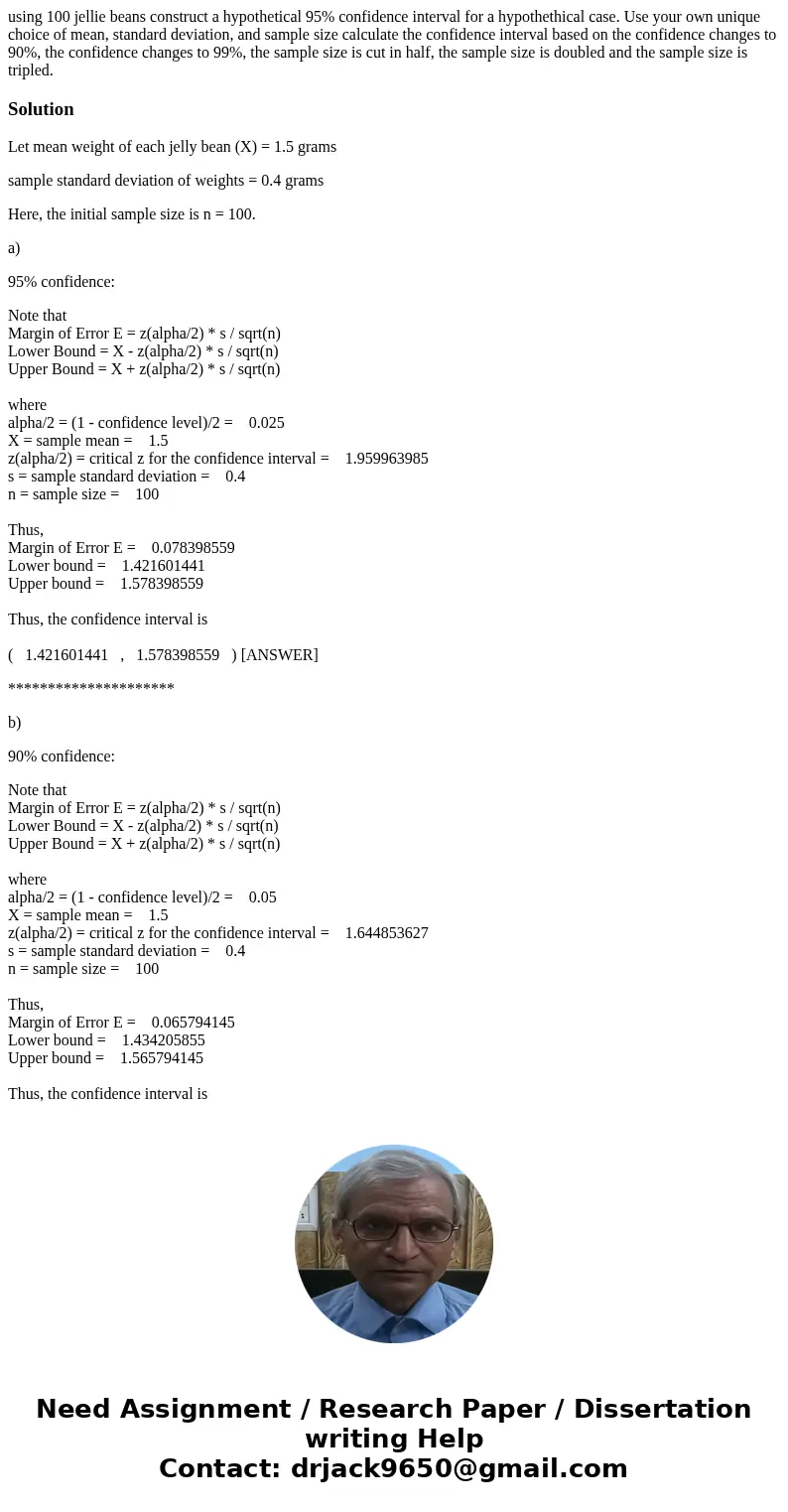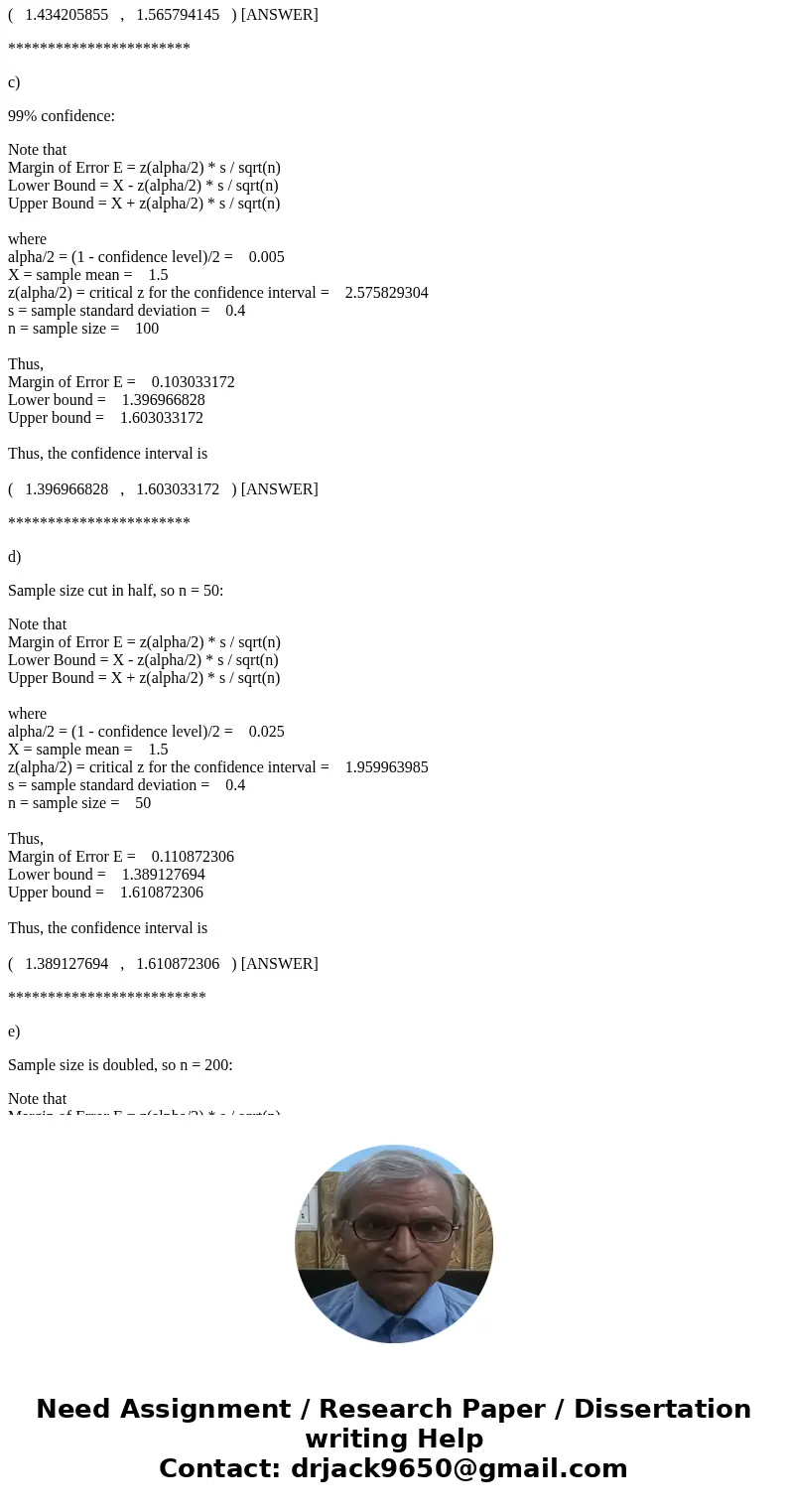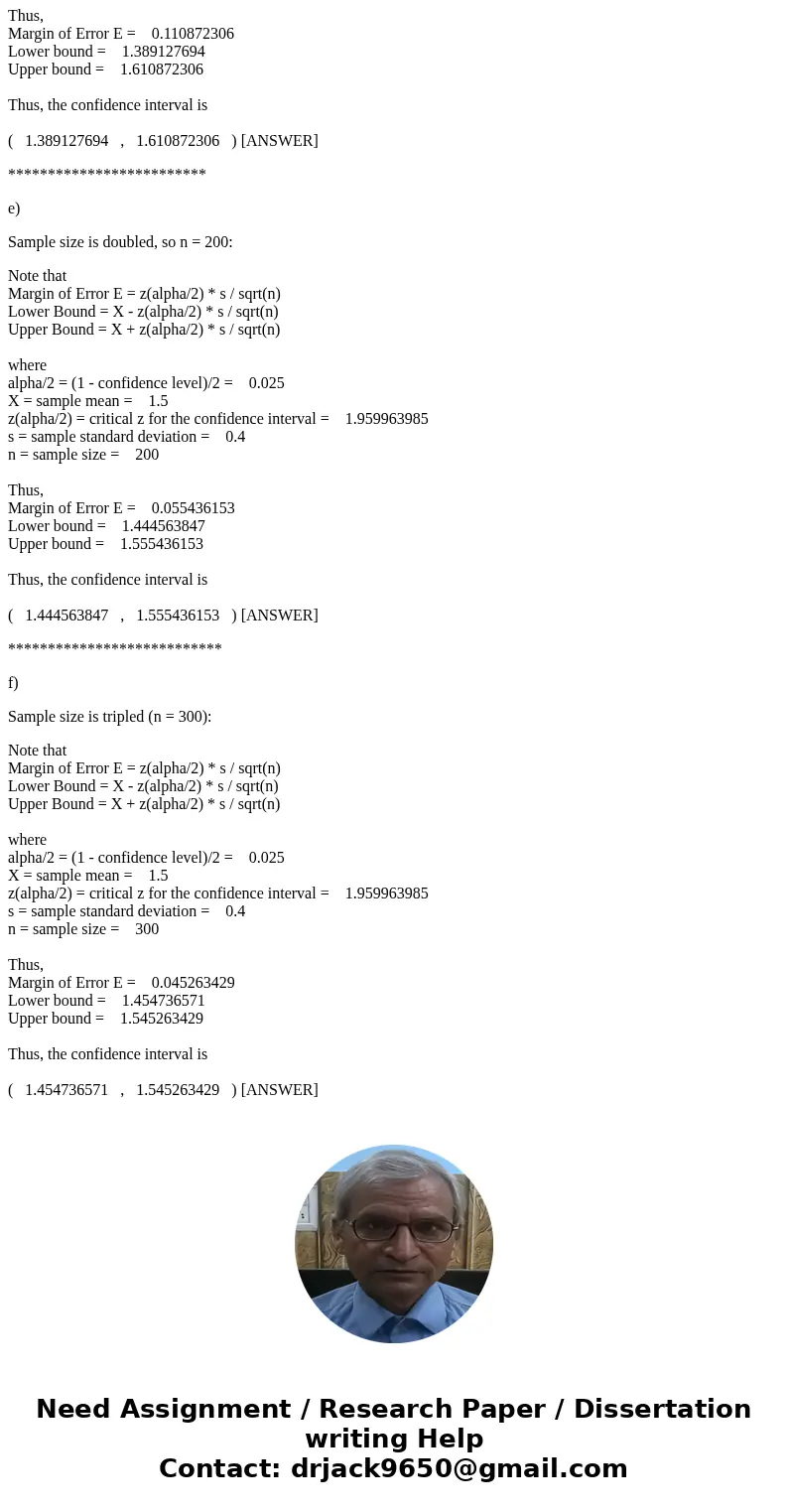using 100 jellie beans construct a hypothetical 95 confidenc
using 100 jellie beans construct a hypothetical 95% confidence interval for a hypothethical case. Use your own unique choice of mean, standard deviation, and sample size calculate the confidence interval based on the confidence changes to 90%, the confidence changes to 99%, the sample size is cut in half, the sample size is doubled and the sample size is tripled.
Solution
Let mean weight of each jelly bean (X) = 1.5 grams
sample standard deviation of weights = 0.4 grams
Here, the initial sample size is n = 100.
a)
95% confidence:
Note that
Margin of Error E = z(alpha/2) * s / sqrt(n)
Lower Bound = X - z(alpha/2) * s / sqrt(n)
Upper Bound = X + z(alpha/2) * s / sqrt(n)
where
alpha/2 = (1 - confidence level)/2 = 0.025
X = sample mean = 1.5
z(alpha/2) = critical z for the confidence interval = 1.959963985
s = sample standard deviation = 0.4
n = sample size = 100
Thus,
Margin of Error E = 0.078398559
Lower bound = 1.421601441
Upper bound = 1.578398559
Thus, the confidence interval is
( 1.421601441 , 1.578398559 ) [ANSWER]
*********************
b)
90% confidence:
Note that
Margin of Error E = z(alpha/2) * s / sqrt(n)
Lower Bound = X - z(alpha/2) * s / sqrt(n)
Upper Bound = X + z(alpha/2) * s / sqrt(n)
where
alpha/2 = (1 - confidence level)/2 = 0.05
X = sample mean = 1.5
z(alpha/2) = critical z for the confidence interval = 1.644853627
s = sample standard deviation = 0.4
n = sample size = 100
Thus,
Margin of Error E = 0.065794145
Lower bound = 1.434205855
Upper bound = 1.565794145
Thus, the confidence interval is
( 1.434205855 , 1.565794145 ) [ANSWER]
***********************
c)
99% confidence:
Note that
Margin of Error E = z(alpha/2) * s / sqrt(n)
Lower Bound = X - z(alpha/2) * s / sqrt(n)
Upper Bound = X + z(alpha/2) * s / sqrt(n)
where
alpha/2 = (1 - confidence level)/2 = 0.005
X = sample mean = 1.5
z(alpha/2) = critical z for the confidence interval = 2.575829304
s = sample standard deviation = 0.4
n = sample size = 100
Thus,
Margin of Error E = 0.103033172
Lower bound = 1.396966828
Upper bound = 1.603033172
Thus, the confidence interval is
( 1.396966828 , 1.603033172 ) [ANSWER]
***********************
d)
Sample size cut in half, so n = 50:
Note that
Margin of Error E = z(alpha/2) * s / sqrt(n)
Lower Bound = X - z(alpha/2) * s / sqrt(n)
Upper Bound = X + z(alpha/2) * s / sqrt(n)
where
alpha/2 = (1 - confidence level)/2 = 0.025
X = sample mean = 1.5
z(alpha/2) = critical z for the confidence interval = 1.959963985
s = sample standard deviation = 0.4
n = sample size = 50
Thus,
Margin of Error E = 0.110872306
Lower bound = 1.389127694
Upper bound = 1.610872306
Thus, the confidence interval is
( 1.389127694 , 1.610872306 ) [ANSWER]
*************************
e)
Sample size is doubled, so n = 200:
Note that
Margin of Error E = z(alpha/2) * s / sqrt(n)
Lower Bound = X - z(alpha/2) * s / sqrt(n)
Upper Bound = X + z(alpha/2) * s / sqrt(n)
where
alpha/2 = (1 - confidence level)/2 = 0.025
X = sample mean = 1.5
z(alpha/2) = critical z for the confidence interval = 1.959963985
s = sample standard deviation = 0.4
n = sample size = 200
Thus,
Margin of Error E = 0.055436153
Lower bound = 1.444563847
Upper bound = 1.555436153
Thus, the confidence interval is
( 1.444563847 , 1.555436153 ) [ANSWER]
***************************
f)
Sample size is tripled (n = 300):
Note that
Margin of Error E = z(alpha/2) * s / sqrt(n)
Lower Bound = X - z(alpha/2) * s / sqrt(n)
Upper Bound = X + z(alpha/2) * s / sqrt(n)
where
alpha/2 = (1 - confidence level)/2 = 0.025
X = sample mean = 1.5
z(alpha/2) = critical z for the confidence interval = 1.959963985
s = sample standard deviation = 0.4
n = sample size = 300
Thus,
Margin of Error E = 0.045263429
Lower bound = 1.454736571
Upper bound = 1.545263429
Thus, the confidence interval is
( 1.454736571 , 1.545263429 ) [ANSWER]



 Homework Sourse
Homework Sourse